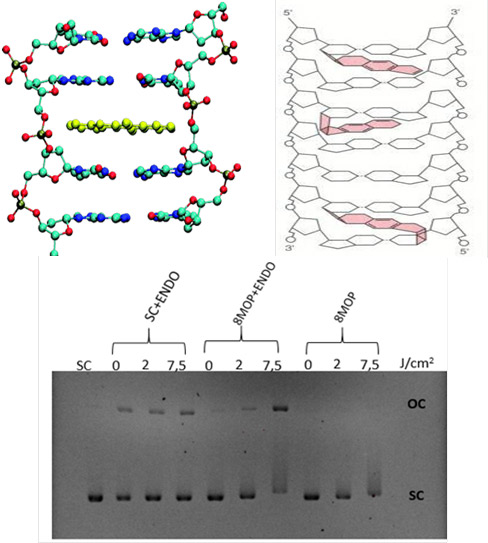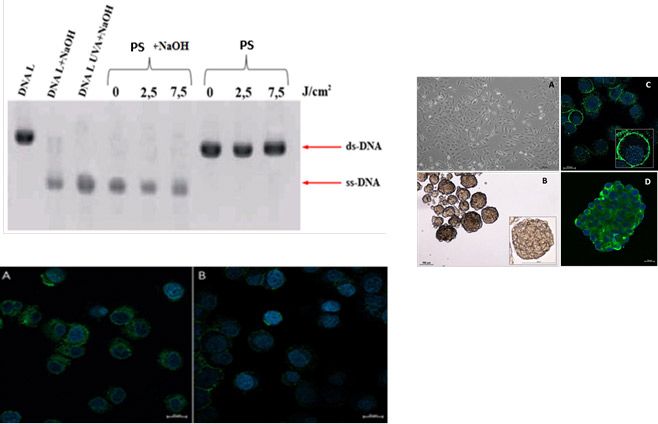Molecular Mechanisms of Drug Action
Topic: The research focuses on disease-selective target identification, drug-target interaction studies at biophysical, biochemical and biological level, and drug-related photochemical/photobiological properties.
Researchers: Barbara Gatto; Claudia Sissi; Alice Sosic; Riccardo Rigo; Giorgia Miolo; Lisa Dalla Via; Cristina Marzano; Valentina Gandin
Current research interests:
- Mechanism of action of known or novel drugs targeted at nucleic acids, alone or in complex with specific proteins, with potential applications in antitumor, antibacterial or antiviral chemotherapy
- Nucleic acids as drugs (aptamers)
- Mass spectrometry-based approaches in drug development
- Development of new RNA-targeting compounds to modulate RNA function
- Characterization of the structural equilibria occurring in DNA sequences playing relevant roles as signaling elements and identification of their ligands
- Photoinduced drug toxicity and photostability (photolysis of medicines and additives)
- Anticancer photoactivable drugs
- Group 10 and 11 metal complexes as target-specific (TrxR, PDK, HDAC) anticancer agents
 | |
Investigation on anticancer compounds
|
read more
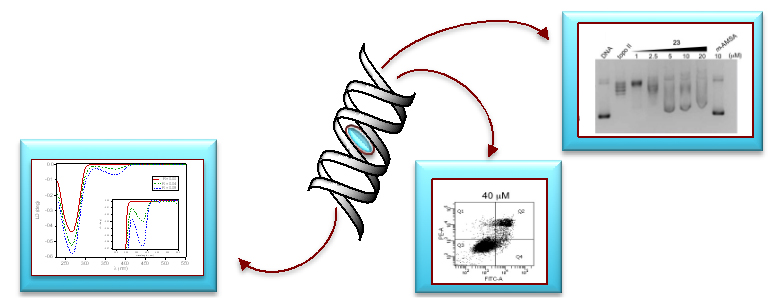 | Organic synthetic compounds Our goal is the investigation of novel chemical structures to establish the interaction with cellular macromolecules, i.e. nucleic acids or proteins, by means of spectroscopic and electrophoretic methods. The effects on the tridimensional structure of nucleic acids and the ability to interfere with the catalytic activity of enzymes, involved in process strictly related with cell proliferation, are studied in depth. Lisa Dalla Via |
|
| |
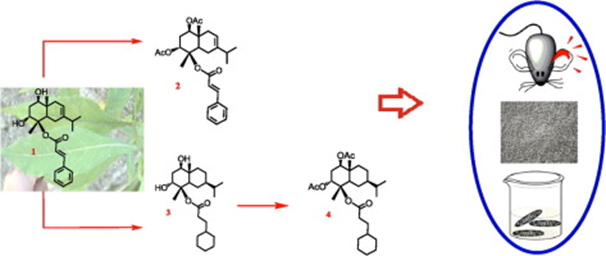 | Natural compounds The aim of the project is the identification of novel natural compounds with potential antitumor activity. Thanks to the collaboration with Mexican research groups, we evaluate the anticancer effect of secondary metabolites isolated from plants used in traditional medicine. The molecular targets responsible of the biological activity are studied and the involvement of different intracellular signaling pathways is investigated on human tumor cells. Lisa Dalla Via |
 | |
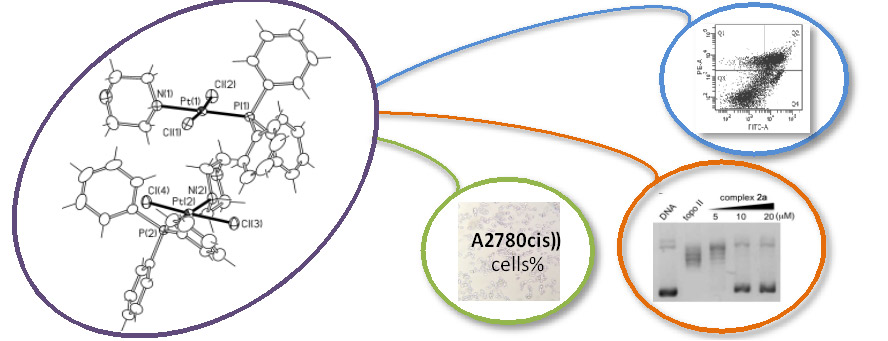 | Metal-based complexes We study new metal-based anticancer complexes with a special emphasis on their interaction with particular receptors and protein targets associated with tumor malignancy. The binding, the cell uptake and the interactions are studied in depth on resistant cells. Cutting-edge technological approaches are employed for the study of drug-target(s) interactions. Lisa Dalla Via |
 | |
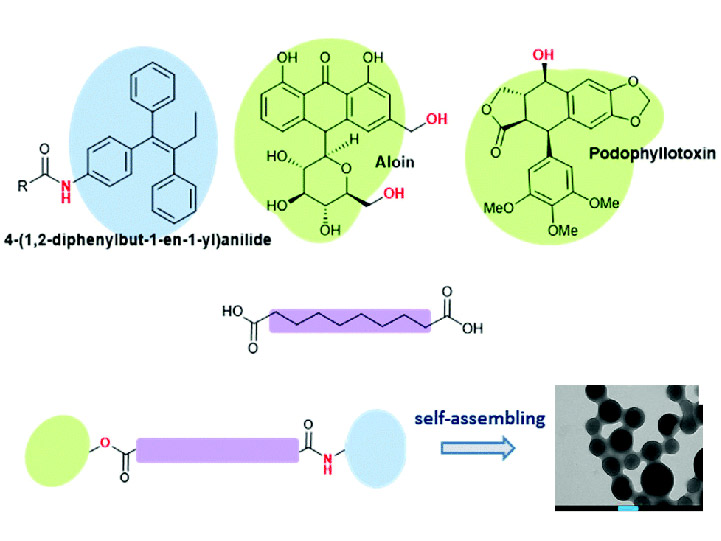 | Self-assembling nanoparticles The need to face the resistance of different kind of tumor cells, move our interest to study new self-assembled nanoparticles obtained by using anticancer drug conjugates. |
 | |
Metal Complexes The Group aims to develop the use of metal-containing compounds as chemotherapeutic agents. As a result, this research is highly interdisciplinary, at the interface of medicinal chemistry, biology and medicine. While the anticancer activity of platinum containing compounds has been the subject of intensive research worldwide, the medicinal properties of other metals have been relatively little explored. We have been involved in the research of novel Group 10 and 11 metal complexes, in particular copper (I,II) complexes, for which a plethora of studies highlighted an high potential as antitumor agents able to circumvent platinum medication drawbacks. We focus on an intensive biological evaluation of the new compounds and on the investigation of their mechanisms of action via the application of analytical techniques coupled to pharmacological methods. The information about structure and activity we get from these studies will allow us to develop new drugs that are not only active in the treatment of many different types of cancer, but which are also very selective and have less side-effects for the patient. Our research allow us to individuate a specific group of copper(I) complexes with promising activity against a number of different types of solid cancers. We are studying their interaction with biomolecules such as DNA and proteins, which are potential targets. |
 | Drugs targeted at nucleic acids
|
read more
 | |
| | NC inhibitors Our aim is to design and investigate the mechanism of action of novel synthetic ligands targeting specific nucleic acid sequences and/or structural contexts in DNA/RNA chains, in particular those relevant for antiviral therapeutic treatment (TAR RNA, cTAR, SL 1-4 of the HIV genome). Searching for compounds able to interfere with the activity of the HIV-1 nucleocapsid (NC) protein, we characterize the physico-chemical parameters of DNA/RNA recognition by established or potential drugs, aimed at the exploration of the Structure-Activity Relationship (SAR) and the elucidation of their putative mechanism of action. Barbara Gatto Alice Sosic |
 | |
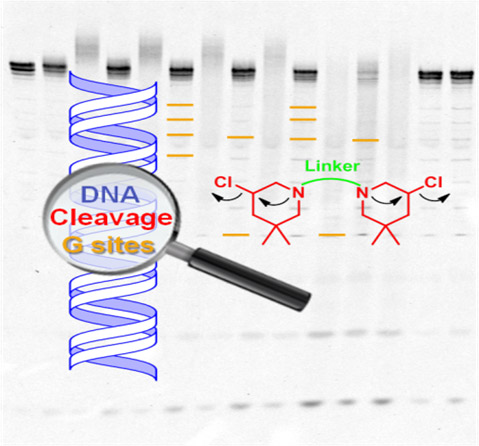 | DNA alkylating agents In collaboration with research groups in Germany and US, we are exploring ideas aimed at the discovery of new chemotherapies whose features were simplicity in synthesis, possible ample decoration of the molecular structure, and an intended mechanism of action whose therapeutic viability had been well established by clinical practices. By simplifying the structure of a complex natural compound with antineoplastic activity, we obtained, through relatively simple synthetic processes, a wide library of bis-chloropiperidines that we verified through various analytical techniques to be DNA alkylators. Our international group is developing the most promising molecules of this class as new chemotherapeutics in the cancer therapy field, analyzing thoroughly their cytotoxicity and pharmacological profile in cancer cells and enhancing their selectivity with the use of intelligent nanotechnology systems. Barbara Gatto Alice Sosic |
 | |
| | Mass spectrometry-based approaches in drug development Mass spectrometry has become a key technology to investigate macromolecular complexes. We employ electrospray ionization mass spectrometry (ESI-MS) to elucidate protein-nucleic acids-ligand interactions in order to obtain valuable insight into the molecular mechanism of action of promising therapeutic agents (antiviral and anticancer agents). We elucidate binding details for different classes of chemical entities, differing in their mode of interaction with the target. In particular, we are exploring compounds acting as DNA and/or RNA cross-linking agents, as well as small molecules able to interact with nucleic acids in a non-covalent manner. The employment of MS as a biophysical tool in drug development allows us 1) to unambiguously elucidate at the molecular level the reactions of small molecules with proteins and/or nucleic acid targets, and 2) to investigate nucleic acids structures, structure-function relationships of nucleic acids-ligands and nucleic acids-protein complexes involved in essential biological processes. Moreover, in collaboration with research groups in Czech Republic and US, we apply ion mobility mass spectrometry (IM-MS) to reveal the dynamics of protein RNA interactions. Barbara Gatto Alice Sosic |
 | |
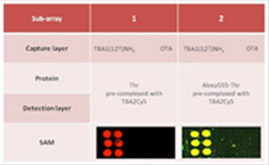 | Aptamers and Aptasensors Besides being drug targets, nucleic acids can also be drugs or valuable sensing systems. Aptamers are nucleic acids discovered employing the technique known as SELEX, or Systematic Evolution of Ligands by Exponential enrichment, a methodology evolved from the unique insight that nucleic acids have sufficient capacity for forming a variety of two- and three-dimensional structures and sufficient chemical versatility available within their monomers to act as ligands with virtually any compound. This powerful technique allows the screening of large combinatorial library of nucleic acids with particular recognition properties. The capability to produce a new diagnostic tool cheaper and easy to use could improve the health system sustainability reducing incorrect or misjudged diagnosis. In addition, innovative sensing system for protein detection are based on the technology of aptamers: thanks to their high stability, selectivity and sensitivity, we are building systems for the detection and quantification of important biomarkers for early diagnosis and prognosis of several pathological conditions. Barbara Gatto, Alice Sosic |
read more
The test compounds should have chemical structure suitable to be targeted at DNA, intercalate inside the double helix and be activated by UVA light. “Drug”-target interaction studies: detection of DNA intercalating agents; isolation and characterization of photo-adducts with target substrates, i.e. salmon testes, calf thymus and PBR322 plasmid DNA, model lipids and proteins; isolation and characterization of photodegradation products as co-responsible for the photobiological activity of test compounds. Methods: UV-Vis spectroscopy, LD-linear dichroism, HPLC and TLC chromatography, gel electrophoresis, UVA/UVB irradiation. Giorgia Miolo
read more
The use of derivatives non-toxic in the dark but that can be activated by hopefully safe light sources is the main gain of phototherapy. In this way, side effects can be limited and only the irradiated diseased area can be damaged in the presence of the photoactivatable compound.
Angular furocoumarins could be activated by UVA light in order to damage DNA with lesions such as the pyrimidine monoadducts. For bifunctional compounds, blue light irradiation may modulate the extent and the types of DNA damage, specially cross-links (XLs), coupled to a still valuable damaging effect. The formation of less mutagenic lesions, i.e. monoadducts over inter-strand crosslinks, would be beneficial for the patient and would lead to a long term safer treatment than under bifunctional photoactivation.
BL is also less toxic per se and more penetrating than UVA light. Therefore, in view of clinical application, blue light may guarantee a safer treatment for surrounding tissues, a deeper penetration into the target tissue and it is also easier to be delivered by an optical fiber than UVA for non skin- solid cancers.
Methods: Photocleavage, crosslink formation, and oxidative damage in pBR322 plasmid DNA by gel electrophoresis, with the use of denaturing conditions for XLs detection and enzymes sensitive to base oxidation for DNA oxidative damage.
Cell viability, Sphere formation, ROS generation, CD44 expression, and apoptosis rate are determined on human cancer cell lines for the evaluation of the antiproliferative/photo-antiproliferative effects and the mechanism underlying the cell photodamage.
The study of furocoumarins photoactivated by UVA and/or Blue light is focused not only to DNA damage and reactive oxygen species generation but also to the modulation of cell signaling pathways. Giorgia Miolo
 | |
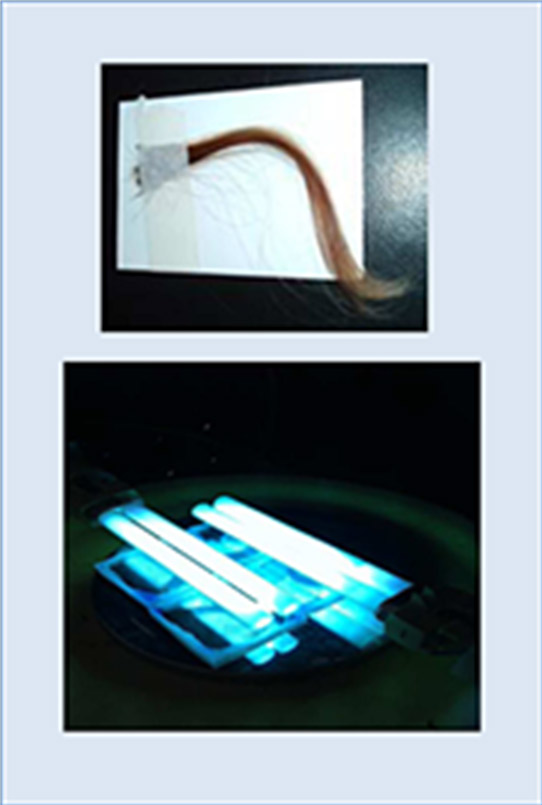 | Photodegradation of illicit drugs in hair The drug content of hair may be affected by washing, chemical or thermal treatments, the use of cosmetics, or exposure to the environment. Knowledge concerning the effect of natural or artificial light on drug content in hair can be helpful to the forensic toxicologist, in particular when investigating drug concentrations above or below pre-determined cut-offs. |
read more
A study on the transformation of illicit drugs and their metabolites by sun light and artificial light in a solar box and under selected UVA-UVB irradiations in authentic positive hair samples, in collaboration with a research group of Forensic Toxicology at Padova University.
Drug concentrations in hair are determined by liquid chromatography-high resolution mass spectrometry before and after exposure to light; moreover, the products of photodecomposition of CNS drugs are useful for the search of new markers of drug abuse; the same photo-treatment of illicit drugs in aqueous solution is suitable in order to investigate the light sensitivity of drugs and their metabolites, with their photo-transformation products, as new pollutants in waters. Giorgia Miolo
 |  |
 | Biophysical Medicinal Chemistry Section Modern drug discovery programs start from target identification and characterization to move forwards to candidate screenings. These new flow requires the support of integrated biophysical technologies able to monitor at molecular level each single component and to follow them interacting with one another. In our section, our expertize on these experimental approaches is exploited to set up projects aimed to better describe at molecular level the mechanisms of action of small molecule as well as to increase the success rate of the finding new drug leads by optimized screening tools. The constant exchance of informations with reserchers with different background covering physic, bioinformatic, computational sciences, chemistry, biotechnology and medicine provides a flexible but solid platform |
read more
| Profiling of nucleic acid foldings Biological macromolecules are highly flexible polymorphic systems. It derives that a comprehensive knowledge of their structural features is the first step to identify them as potential targets and to start a successful drug discovery program. In our lab we integrate a panel of biophysical approaches to define the folding of selected physiologically relevant DNA and RNA sequences. This study is applied to sequences of different complexity in terms of length or presence of multiple structural modules. As a results we can derive the kinetic and thermodynamic parameters ruling the folding equilibria of our target in solution and the environmental factors that the modulate them. In addition to the canonical double helix, In the most recent years we applied this approach to aptamers, telomers, promoter region of oncogenes which can assume tetrahelical strucuture such as G-quadruplex or/and I-motif (c-KIT, c-MYC, B-RAF, EGFR, BLC2….). Claudia Sissi |
| |
 | Selective targeting of nucleic acids Targeting of nucleic acids by small molecules is a strategy that finds applications in therapy (anticancer, antibacterial and aniviral drugs) as well as in diagnostic. The macromolecules-ligand interaction is a multicomponent process but it is possible to study it along each single step. This approach provides a comprehensive overview of the structural requirements of the ligand thus improving rational ligands design and optimization. Currently ongoing projects in this field cover: Protein-DNA recognition; G-quadruplex ligands; Synthetic nucleases; Biosensors. Claudia Sissi |
 | |
 | Topoisomerases poisons Topoisomerases are key enzymes which are required for the proper progression of cell cycles in eukaryotic and prokaryotic cells. A validate mechanism of action for efficient anticancer and antibacterial agents is represented by the induction of a DNA damage trough the impairment of their normal activity. Worth of note, this can occur at different stage of the enzyme catalytic cycle. Along the years we acquired a valuable knowhow on the study of these mechanism and now, with the recent advances on the structural characterization of these proteins we are using it to further optimize their targeting by new selective and potent small molecules. Claudia Sissi |
 |



